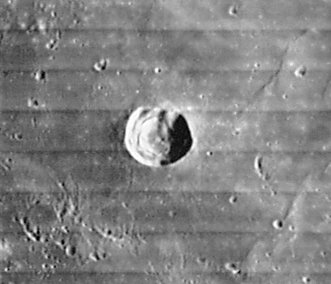Difference between revisions of "Galle"
| Line 16: | Line 16: | ||
[http://en.wikipedia.org/wiki/Galle_(crater) Galle]<br /> <br /> | [http://en.wikipedia.org/wiki/Galle_(crater) Galle]<br /> <br /> | ||
==Additional Information== | ==Additional Information== | ||
| − | * Depth data from [[Kurt%20Fisher% | + | * Depth data from [[Kurt%20Fisher%20Crater%20Depths|Kurt Fisher database]]<br /> Westfall, 2000: 2.55 km<br /> Viscardy, 1985: 2.3 km<br /> Cherrington, 1969: 2.01 km |
* TSI = 25, CPI = 5, FI = 15; MI =40 [[Smith%20and%20Sanchez%2C%201973|Smith and Sanchez, 1973]] | * TSI = 25, CPI = 5, FI = 15; MI =40 [[Smith%20and%20Sanchez%2C%201973|Smith and Sanchez, 1973]] | ||
<br /> | <br /> | ||
Latest revision as of 01:49, 16 April 2018
Contents
Galle
|
Lat: 55.9°N, Long: 22.3°E, Diam: 21 km, Depth: 2.55 km, Rükl: 5, Eratosthenian |
Images
LPOD Photo Gallery Lunar Orbiter Images
Maps
(LAC zone 13D2) LAC map Geologic map
Description
Description: Wikipedia
Additional Information
- Depth data from Kurt Fisher database
Westfall, 2000: 2.55 km
Viscardy, 1985: 2.3 km
Cherrington, 1969: 2.01 km - TSI = 25, CPI = 5, FI = 15; MI =40 Smith and Sanchez, 1973
Nomenclature
- Johann Gottfried Galle (June 9, 1812 – July 10, 1910) was a German astronomer at the Berlin Observatory who, with the assistance of student Heinrich Louis d'Arrest, was the first person to view the planet Neptune, and know what he was looking at (September 23, 1846). He used the calculations of Urbain Le Verrier to know where to look.
- According to M.G.J.Minnaert, there seems to be one of the terrestrial atmospheric halo phenomena which is called the Tangential Arc of Galle, or the Upper Tangent Arc of Galle (Bovenraakboog van Galle). See: page 218 in Light and Color in the Outdoors (M.G.J.Minnaert/ Len Seymour/ Pekka Parviainen), and page 231 of Minnaert's original De Natuurkunde van 't Vrije Veld; Volume 1.- DannyCaes Dec 12, 2010
LPOD Articles
Bibliography
